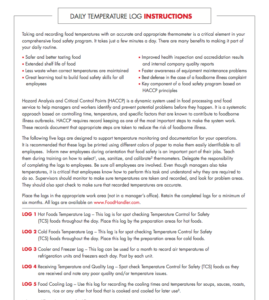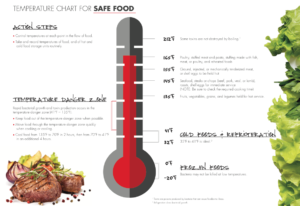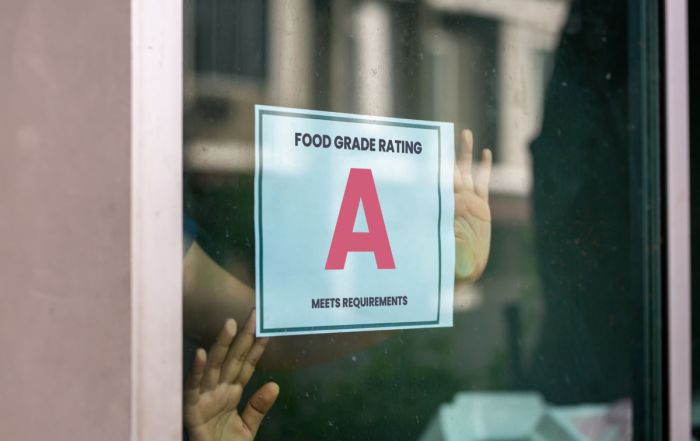SafeBites Time and Temperature Control: How To’s
Welcome back! In the last blog I gave the low down on temperature controlled for safety (TCS) foods and the temperature danger zone (TDZ). The focus of this blog is all about control of time and temperatures of foods in your operations. You might say we are discussing Control Issues! Kidding aside, knowing that temperature abuse is a leading cause of foodborne illness, it only makes sense to pay attention to the time that TCS foods are in the TDZ (remember, that is between 41° F and 135° F). FoodHandler® recently updated some useful time and temperature documentation tools.
These logs provide guidance about when to check temperatures of foods and food storage units with a structured format that includes the necessary information needed for record keeping.
As operators, there needs to be a focus on the time TCS foods are in the TDZ controls for both quality and safety. All staff should be alert as food flows through the operation – from purchasing to service. Operations make every effort to purchase from reputable suppliers who are paying attention to temperature controls. Before foods are accepted, it makes sense to verify that the food delivered meets the quality and quantity specifications that was ordered. Part of quality checks involves temperature. If a ready-to-eat bagged salad green arrives at 50° F, then it is advised that product not be accepted into the custody of your foodservice, as it is unknown how long this TCS food was in the TDZ. Remember, once product is accepted, you own it! After product is accepted, don’t let it sit on the loading dock for extended periods of time as that not only can lead to temperature abuse, it negatively affects quality, AND there is potential for theft, or worse, intentional contamination of the food. Placing foods into the proper storage unit as soon as possible provides control. A new Refrigerator Storage and Food Placement poster from FoodHandler® reinforces these tips as well as controls against cross contamination.
Include in contracts with vendors that deliveries will not be accepted during meal times to ensure good receiving practices are followed and to allow time for proper storage. Also document when a delivery is not acceptable as this can provide information useful when making decisions about vendors.
If frozen foods need to be thawed for use (like 30 lb. containers of eggs), be sure these are pulled with enough time to thaw under refrigeration. Large containers will not thaw overnight; plan ahead and allow several days. Communicate on production schedules when foods should be pulled and placed in the cooler. Of course, some frozen foods, like hamburgers, can be panned and cooked from the frozen state.
During preparation, encourage staff to think in terms of batches. Batch cooking, also known as just in time service or a market display concept, has benefits of improved quality and appeals to customers’ sense of freshness and customization. It also makes sense from a safety perspective. Think about it. Even if the forecast or production order is for 100 ham sandwiches, it doesn’t make sense to bring out all the ham needed to complete this order at once. Rather, encourage staff to bring out smaller amounts. Or if pans of hot food product are to be served, stagger the cooking schedule; you may find that the last pan or two is not needed! This may have positive impacts on food costs as well! There are some good training resources in the Do Your PART series from Iowa State University.
If there is hot food left over after service and the operation decides to store for future service, it is critical that proper cooling occurs. Remember the “super” TDZ is between 70° F and 135° F; therefore, hot food temperatures must drop to below 70° F within 2 hours, and to below 41° F within an additional 4 hours. The FoodHandler® Temperature Chart for Safe Food can provide a helpful, visual reminder.
There are tips on how to meet these standards even if a blast chiller is not onsite. One way is to portion leftover product into smaller units. Another is to put pan in a pan of ice and stir the product. Some operations purchase chill sticks. These are internal ice baths and can lower temperatures of liquid-based foods more quickly. Keep in mind that cooling is not easy to accomplish, so time and temperature monitoring is critical to make sure your techniques are working.
In the last blog, Time as a Public Health Control (TPHC) was mentioned as one option. Remember though, there are certain actions that need to be taken, including documentation of time and temperature that foods were removed from temperature controls of hot or cold holding. The new logs developed by FoodHandler® can be used for these purposes also.
The general rule of thumb is to minimize time TCS foods are in the TDZ. Taking actions to control for temperature abuse also maintains quality of menu items served. The key is planning, and having clear guidance available so everyone knows the proper actions to take. Generally, people are more inclined to follow procedures if they understand why they are in place.
In these last two blogs, the why and when of temperature controls, along with some tips on how to do so, have been presented. As a result, you can take control to prevent illness from food in your operation that was temperature abused. In this case, having control issues is a good thing!
Cathy
READ MORE POSTS
Embracing Technology for Enhanced Food Safety in Foodservice Operations
Technology. We love it, we hate it. I’ve always been fascinated by technology; I remember getting my first Blackberry in the mid-90s and thinking it was the pinnacle of technological advances. Before that, I remember ordering a dictation program in college that was going to revolutionize the way I “typed” my assignments. Looking back, it really wasn’t worth the box that the program came in. Now, we have ChatGPT that will write the entire paper for us!
Meat Color and Doneness: Persistent Pinking
Late in June, my family and I were able to visit the Black Hills, an area of the country in which I have not had the opportunity to spend much time. One evening, as we dined at a local restaurant, I observed a table across the dining room sending back a dinner. While I couldn’t hear the entire conversation and I certainly wasn’t trying to eavesdrop, it was apparent that the customer was unhappy with the cooking of their hamburger and was sending it back because it was too pink in the middle. That immediately brought to my mind the phenomenon known as persistent pinking. A term I became familiar with because of work done by some colleagues here at Kansas State, which they present each summer to a group of foodservice operators who join us on-campus for an in-depth week-long look at all things food safety.
Quat Binding – Why this Can Have a Disastrous Impact on Your Sanitation Program.
In June, I had the opportunity to represent FoodHandler and speak on food safety behavior for customers of Martin Bros. Distributing in Waterloo, Iowa. One of the questions that was asked caught me a little off guard. The question was about quat binding. It caught me off guard not because it was a bad question, but only because it was not something I had previously been asked nor had not yet been exposed to the phenomenon. However, I soon learned that in certain jurisdictions, it is resulting in changes to how sanitizing cloths are to be stored in sanitizing buckets (or not) in the foodservice industry. When I returned home from the trip, I had to dig into it to learn about what quat binding is and how it might impact foodservice operations.
Are Grades for Foodservice Inspections a Good Idea?
I generally try to stay away from controversial topics in my blog, but this is one I thought it might be interesting to discuss. Occasionally on my travels, I will come across a state or a local jurisdiction that requires foodservice inspection scores be posted in the window of the establishment. The idea is to allow would-be customers the ability to see how the foodservice operation in which they are about to eat scored on their latest health inspection.














